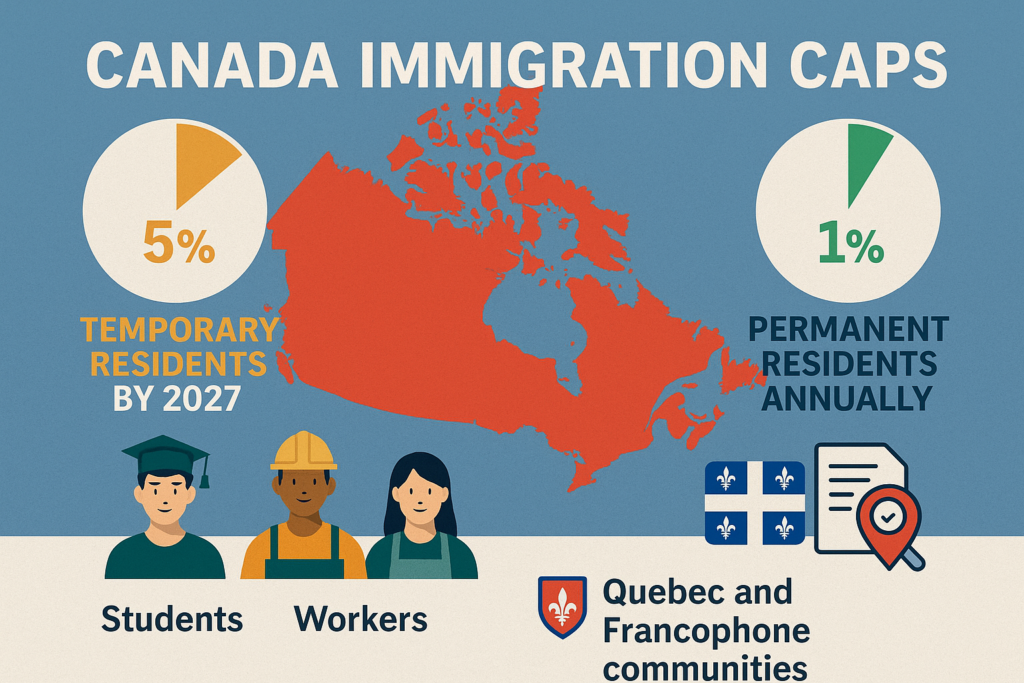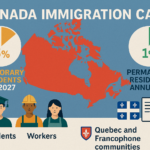- +1 204-898-8510
- [email protected]
- 201-575 St. Mary's Rd, Winnipeg, MB R2M 3L6 Canada
- Home
- Canada Immigration Caps Unveiled: 2025 Policy Highlights
Canada Immigration Caps Unveiled: 2025 Policy Highlights
Exploring the New Canada Immigration Caps: A Deep Dive into 2025 Limits and Strategies

Canada Immigration Caps have become a focal point in the 2025 federal platform, as the Liberal Party under Mark Carney proposes measures to align newcomer intake with Canada’s capacity for housing and services. The plan sets clear limits on both temporary and permanent residents to foster a sustainable immigration trajectory. Readers seeking detailed insights can review the full policy here.
Permanent Resident Admissions at 1% of Population
The new policy stipulates that permanent resident admissions will be stabilized at less than 1% of Canada’s population each year beyond 2027. In practical terms, this translates to approximately 400,000 new permanent residents annually, a figure that aligns with the current Immigration Levels Plan projections. These Canada Immigration Caps aim to ensure that newcomers can access essential services such as housing, healthcare, and employment without overwhelming existing infrastructure.
Temporary Residents Capped at 5%
Under the proposed Canada Immigration Caps, the total number of temporary workers and international students will be limited to under 5% of the national population by the end of 2027. This represents a reduction from a recent high of 7.3%, reflecting concerns about strains on housing and social services. By setting this cap, the government intends to better balance short‑term economic needs with community capacity.
Revitalizing the Global Skills Strategy
A key element of the immigration plan is the revitalization of the Global Skills Strategy to attract top global talent, especially for high-growth Canadian businesses. This includes streamlined pathways for highly skilled workers from the United States to support strategic economic initiatives in Canada. These measures under Canada Immigration Caps are designed to strengthen competitiveness and innovation in key sectors.
Streamlined Credential Recognition
To help newcomers integrate more quickly into the workforce, the plan emphasizes collaboration with provinces and territories to accelerate recognition of foreign credentials and international professional experience. Faster credential recognition under these Canada Immigration Caps will enable skilled immigrants to contribute their expertise upon arrival, reducing underemployment and promoting economic growth.
Digital Service Enhancements
The government intends to leverage digital service tools to reduce processing times and eliminate application backlogs, aiming for a fairer and faster system for families, businesses, and applicants. These digital enhancements are integral to the Canada Immigration Caps framework, improving transparency and reliability in immigration services.
Support for Asylum Seekers and Refugees
Under the new Canada Immigration Caps, legal aid support will be strengthened for asylum seekers and refugees, ensuring timely advice, representation, and reduced appeal delays. The plan also reaffirms Canada’s commitment to prioritize the world’s most vulnerable, including human rights defenders and refugees, within the capped intake levels.
Border Integrity and Enforcement
To reinforce system integrity, the platform proposes increased resources for security screenings, expedited removal of inadmissible individuals, tighter visa requirements, and stronger measures against immigration fraud. These border measures complement the Canada Immigration Caps by securing entry points and upholding confidence in the immigration system.
Quebec and Francophone Collaboration
Recognizing Quebec’s unique role, the policy continues joint responsibility under the Canada‑Quebec Accord, respecting Quebec’s authority over its immigration levels to protect French language and culture. Additionally, a target of 12% for Francophone immigration outside Quebec by 2029—a 20% increase—will strengthen Francophone communities nationwide, in line with Canada Immigration Caps goals.
Canada Immigration Caps reflect an effort to balance growth with sustainability, ensuring that newcomers enrich Canadian communities while maintaining service quality. For further reading on related developments, explore recent posts on our blog:
Convinced you need tailored guidance? Reach out to Mesidor Immigration for an eligibility assessment:
Contact Us for Your Immigration Eligibility Assessment – Mesidor Immigration
Sharing is caring.
Share this information within your social circles.
Contact Us

Phone/WhatsApp: 204-898-8510
Email: im*********@*****or.ca
Address: 201-575 St. Mary’s Road, Winnipeg, MB, R2M 3L6
Search the Site
Recent Immigration News Posts
- Canada’s 2025-2027 Immigration Policy: Key Updates and Strategic Shifts

- Education-Targeted Express Entry Draw #344: Key Highlights

- Canada Immigration Caps Unveiled: 2025 Policy Highlights

- Canada’s New Home Care Worker Immigration Pilots: What You Need to Know

- Express Entry CRS Points for Job Offers Removed: What You Need to Know

- Canada Expands Parents and Grandparents Program to 25,000 Applications

- Maritime Provinces Take Bold Steps Toward the Elimination of Racial Discrimination

- Largest Express Entry Draw on March 21, 2025: 7,500 Invitations Issued for French Language Proficiency Candidates

- New Credit Score System Expands Opportunities for Newcomers in Canada

- Canada’s $9.3M Investment to Strengthen Francophone Minority Communities

- Yukon Opens Requests for Support Letters for Expiring Work Permits

- Insights from the March 18, 2025 BC PNP Entrepreneur Immigration Draw

- Canada-Greece Tourism Agreement: New Opportunities for Travel and Immigration

- Alberta Advantage Immigration Program (AAIP): March 14, 2025 Update

- Yukon Extends Work Permit Support: Key Information for Foreign Nationals


Recent Comments